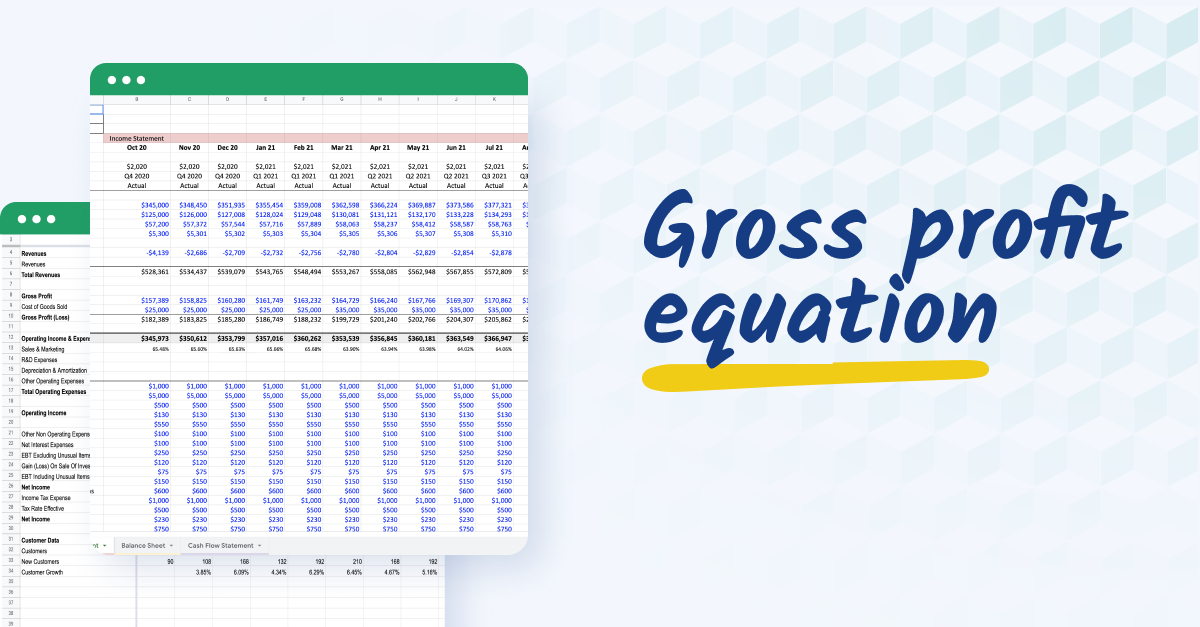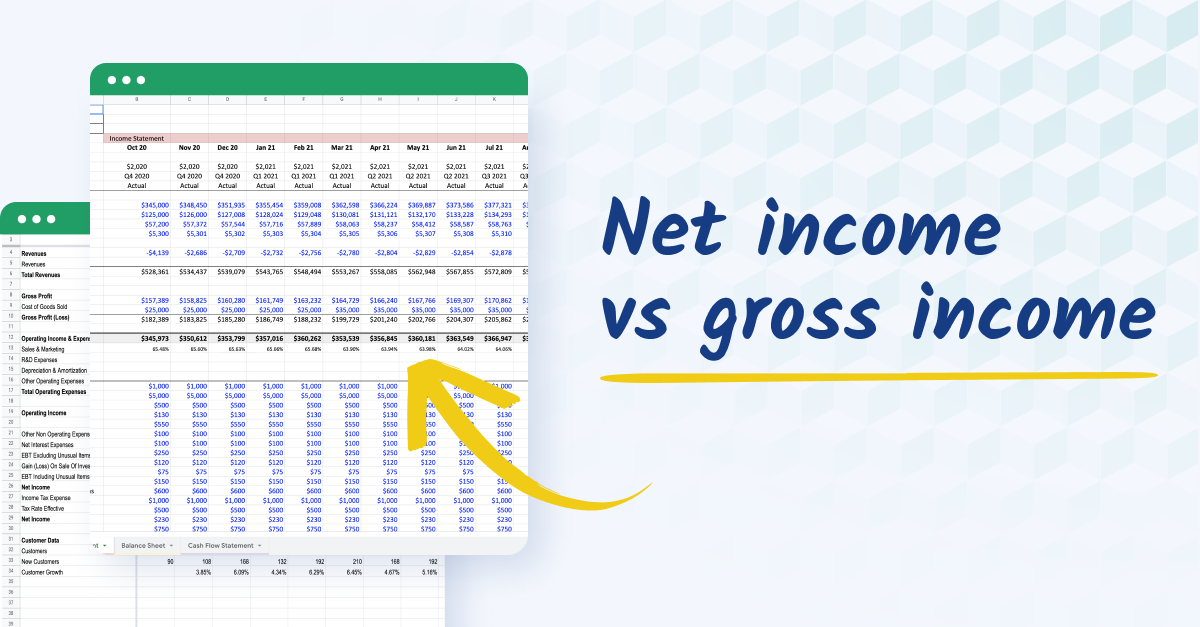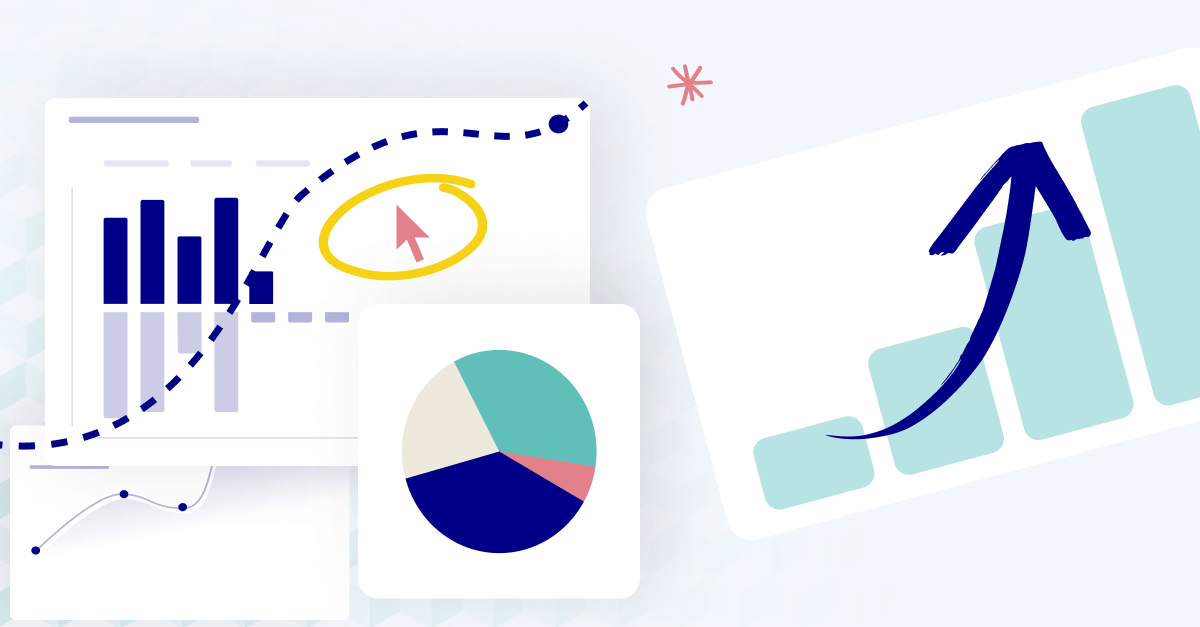What is gross profit?
Gross profit represents the amount a company retains after deducting the cost of goods sold (COGS) from its total revenue. It measures a company's financial health by showing how efficiently it sells goods or services.
The equation for gross profit is a simple subtraction: Total revenue minus COGS. This equation helps businesses understand their production and distribution costs and assess profitability.
Unlike net profit, which accounts for all business expenses, gross profit focuses solely on the direct costs associated with producing goods or services.
What is included in gross profit?
To calculate gross profits, you need to know what to include, which depends heavily on your industry.
Gross profit focuses on the revenue directly tied to the sale of goods or services. That is fairly easy to understand. Every time you strike a deal, your profit goes into the equation.
However, the cost of goods sold is more difficult to pinpoint. COGS covers all costs directly associated with the production of a product, such as raw materials, labor, and manufacturing expenses.
Operating expenses like rent, utilities, administrative costs, and other costs that aren’t directly linked to the production process should not be included in COGS—and are therefore left out of the gross profit calculation. These expenses fall under operating costs and are deducted further down the income statement to determine net profit.

Why gross profit is important for finance teams to measure and understand
Gross profit is one of the most important finance statistics for any business because it lays the foundation for strategic finance analysis and decision-making. By measuring and understanding gross profit, you can:
1. Analyze your company’s fiscal performance
The first benefit of a gross profit analysis is its ability to show a company how well it generates income relative to production costs. If you can’t keep control of production costs, even the highest-revenue companies aren’t sustainable. A gross profit report can serve as an early warning sign that you need to tighten the purse strings.
By tracking gross profit over time, businesses can assess whether their approach is effective. A steady or improving gross profit margin suggests a healthy balance between production costs and revenue, while a declining margin may signal inefficiencies, rising costs, or the need for pricing adjustments.
2. Develop effective pricing and cost management strategies
Ongoing profitability analysis keeps you updated on your performance. This can be a springboard for developing strategic pricing models that maximize profitability without becoming less competitive. By understanding the cost of goods sold and how it affects gross profit, businesses can adjust pricing to cover costs and ensure a healthy margin.
Additionally, this analysis helps identify areas where cost reductions are possible, like negotiating better terms with suppliers or optimizing production processes. When leveraged effectively, the gross profit equation can strike the balance between competitive pricing and cost management—the cornerstone of sustainable growth.
3. Discover the link between gross profit and your total profitability
Gross profit is an important component of a company’s overall profitability, serving as a starting point for calculating first earnings before interest and taxes (EBIT), then net profit. While gross profit focuses on direct production costs, total profitability or net profit encompasses all expenses, including operating costs, taxes, and interest.
A strong gross profit margin can indicate that a company’s core operations are sound, but to achieve total profitability, you also need to manage indirect expenses. However, a healthy gross profit margin sets a solid foundation for greater net profits and long-term financial success.

The equation for gross profit
As we saw earlier, the formula to calculate gross profit is:
Gross Profit = Net Revenue − Cost of Goods Sold
In this section, we’ll dig a little deeper into how to calculate your gross profit and how to interpret the results in the wider context of your business.
Key elements of the gross profit formula
To use the formula correctly, you’ll need two key pieces of information: your total revenue (i.e., the income generated from the sale of goods or services) and the cost of goods sold (i.e., all direct costs related to the production of those goods or services).
Total revenue includes all income generated from the sale of goods or services during a specific period. Therefore, if you want to find your gross profit for last year, you only need to pull figures from the year in question.
The revenue figure should be net of any discounts, returns, or allowances to reflect the actual sales amount. Ignoring these irregularities could paint an artificially positive picture, meaning you overlook issues with your approach. For example, if your sales are above expectations but you fail to account for a 20% return rate, you’ll be less likely to look into why so many customers are dissatisfied.
The cost of goods sold encompasses all direct costs associated with producing the goods or services sold by the company. This typically includes:
- Direct materials: Costs of raw materials or components used in the production of goods.
- Direct labor: Wages or salaries of employees who are directly involved in the manufacturing or production process.
- Manufacturing overheads: Expenses directly tied to the production process, such as factory utilities, equipment depreciation, and maintenance.
Be sure to keep your internal accounting policies and wider market conditions in mind. Internal protocols will define any adjustments you may need to make for accruals, deferrals, or inventory valuations, such as the First-In, First-Out (FIFO), or Last-In, First-Out (LIFO) methods. With this information, you can spot links between profit margins and company policy.
Market conditions can also affect your profitability. For example, a rise in inflation will cause a rise in material costs, so you’ll have to take decisive action to avoid shrinking profit margins.
Calculating gross profit
While the calculation is relatively straightforward, it can be hard to bring all your revenue and cost of goods data together.
In the past, this was a painful, time-consuming process. But now, financial tools like FP&A software make it easier and faster to calculate gross profit while eliminating risks that could skew your analysis.
Centralized FP&A tools like Cube automatically pull real-time revenue and COGS data directly from your financial systems to instantly generate accurate gross profit figures.
Rather than relying on manual calculations, you can prepare financial statements instantly. If you need to switch the timeframe, a few clicks of a button will change your view from yearly to all-time gross profit.
Converting gross profit into a gross margin
Gross profit as a standalone metric may not provide a complete picture of a company’s financial performance. However, you can convert your gross profit into a percentage format, known as gross margin, for more meaningful comparisons.
The formula for calculating the gross margin is:
Gross margin (%) = (Gross profit / revenue) x 100
Gross margin represents the percentage of revenue remaining after subtracting COGS, which includes direct costs like materials and labor. This percentage allows companies to compare their profitability with industry peers or investors to identify the best sectors in terms of profit.
On a company level, a higher gross margin generally indicates better cost management and the potential for greater overall profitability. Therefore, by comparing your gross margin over time, you can maintain steady growth with pricing and cost adaptations.

An example of gross profit calculation
To put gross profit calculation into perspective, let’s consider an example of a fictitious company, Dani’s Apparel, which sells clothing and accessories.
In the last fiscal year, Dani’s Apparel reported $500,000 in revenue from clothing sales and $200,000 from accessories, totaling $700,000 in net sales. The COGS for clothing was $300,000, and for accessories, it was $100,000, bringing the total COGS to $400,000.
To calculate the gross profit:
Gross profit = $700,000 − $400,000 = $300,000

Next, we calculate the gross margin:
Gross margin (%) = ($300,000 / $700,000) x 100 = 42.9%
Dani’s Apparel retains about 42.9% of its revenue after covering the direct costs of production.
What is considered a "good" gross profit?
Whether a gross profit is “good” depends largely on the industry context and the specific characteristics of the company. Before making any comparisons, you need to standardize gross profit by converting it into a gross margin percentage.
A higher gross margin generally means better cost efficiency and the potential for stronger operating and net profit margins. Companies without physical products, like SaaS providers, often report higher gross margins for software and subscriptions than their product-focused counterparts due to lower costs for materials, production, and inventory.
A full:ratio study shows the stark difference in gross profit margins between niche industries, with regional banks enjoying 99.8% and auto manufacturers languishing at 6.1% (see below). This is one of the reasons car companies controversially introduced low-COGS subscription services for heated seats and remote-start key fobs.

Image source: full:ratio
Ultimately, gross margins are only comparable with companies in the same industry. Comparing a manufacturing company with a financial services provider will make for bad reading and a profit margin gap that’s almost impossible to bridge.
Like-for-like comparisons provide a far more realistic picture, which makes financial forecasting more manageable.
Mistakes to avoid when calculating gross profit
Of course, you can’t rely on one metric for all your financial planning. Calculating gross profit comes with a few common pitfalls you’d do well to avoid, and some limitations when conducting detailed analysis. These include:
- Misclassifying expenses: Only direct production costs are included in COGS, so remember to exclude operating expenses like rent, marketing, and administration.
- Inconsistent time periods: Match the time periods for both revenue and COGS to avoid inaccuracies in gross profit calculations.
- Ignoring inventory changes: Account for changes in inventory levels to reflect the true cost of goods sold.
- Overlooking segment analysis: Perform gross profit analysis by segment to identify the most profitable areas of the business.
- Relying on manual calculations: Use data entry automation to reduce errors and save time when calculating gross profit.
- Relying solely on standardized statements: Standardized income statements from financial data services may vary, particularly when comparing public and private companies.
- Failing to investigate gross profit discrepancies: Dig deeper into revenue streams and COGS components if your gross profit is significantly lower than competitors.
- Misinterpreting gross profit for service companies: For service sector businesses, gross profit may not account for substantial below-the-line expenses, leading to a misleading assessment of your profitability.
Get simple solutions to your toughest financial questions
Gross profit is a key indicator of any company’s core financial performance, but calculating it isn’t the easiest task. From time spent categorizing COGS, errors in your calculations, and a failure to link it up with other important financial metrics, the calculation can feel like more of a hindrance than a benefit.
Thankfully, FP&A software like Cube streamlines gross profit calculations, offers real-time financial visibility, and connects all your financial processes on one dashboard.
Want to learn more? Schedule a free demo with Cube.



.png)











